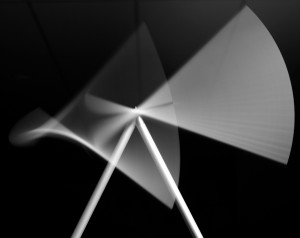I’m feeling a little lazy today, so this is a cross-posting from the University of Michigan Risk Science Center newsletter. It draws in part on the talk I gave at the Cincinnati Contemporary Arts Center this past weekend as part of their “where do we go from here?” series. The whole setup at CAC by the way was excellent – engaged audience, great space, and wonderful staff.

Slow exposure of a complex pendulum, used to illustrate the challenges of addressing risks in a technology-dependent and integrated world.
In early December, I found myself in the bizarre position of giving a public lecture on risk science at the Cincinnati Contemporary Arts Center. Despite the seemingly strange juxtaposition of art, risk and science, together with my wife’s admonitions of “what do you know about art anyway?!” it was an immensely gratifying event – not least because it forced me to think about what risk science means to people who aren’t in the risk business.
The question of what risk science is was one that I had tackled a couple of weeks previously at the inaugural Charles and Rita Gelman Risk Science Professorship lecture. Here, I argued that in a complex world, blindly following our instincts can actually increase the chances of people being harmed. What we need is a systematic and unbiased way of addressing human health risks. Science provides a great solution here – by focusing on prediction, evidence and correction, it factors human foibles out of the decision-making process; at least in principle. Hence “risk science” as a basis for evidence-driven decision-making.
But then I asked – is this vision of risk science enough to keep us healthy, wealthy and wise in the 21st century? The answer was no. Hard data are clearly critical to informed decision-making. But the numbers just aren’t aren’t enough when it comes to making decisions within increasingly complex and highly interconnected systems. In today’s society, we also need to understand and respond to a whole host of other factors that influence the effects associated with certain courses of action. In other words, if we are to make effective decisions on human health risks in the 21st century, our concept of “science” in “risk science” needs to expand to cover expertise in the social, economic and political sciences and beyond.
As you might imagine, this was the starting point for some interesting conversations at the Contemporary Arts Center. And one that particularly intrigued me was the question of how you help people make good decisions on risk in the face of all this complexity and interconnectedness? How do you forge connections between people that increase the chances of them making evidence- based and socially-responsive decision-making? One of the answers was – unsurprisingly given the setting – through art. Where facts fail, art enables connections to be made and understanding to flow between people in ways that circumvent our struggle to make sense of cold numbers.
Which begs the question – is “risk science” broad enough to embrace the arts as well, or do we need to start thinking about a complimentary field of “risk arts?”
The Risk Science Center newsletter with the original piece can be read here.

Great question Andrew!
Not sure if you have seen a book I was recently involved in editing “Nano meets Macro: Social perspectives on nanoscale sciences and technologies” but in there we included 10 original works of art that reflected on questions around nano sci & tech. My colleague and I saw art as a complementary way of exploring social and ethical aspects of science and technology development with great potential to reach different publics than standard academic research. Wonderful to think about how these approaches might be combined for risk issues!
Thanks Fern – I was aware of the book but haven’t read it. Just ordered a copy!
great post. thank for information.